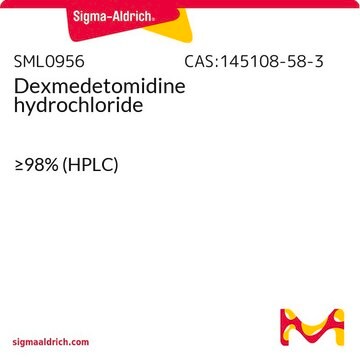SML0255
4-DAMP
≥98% (HPLC)
Synonyme(s) :
1,1-Dimethyl-4-diphenylacetoxypiperidinium iodide, 4-DAMP methiodide, 4-Diphenylacetoxy-N-methylpiperidine methiodide, 4-[(Diphenylacetyl)oxy]-1,1-dimethyl-piperidinium iodide
About This Item
Produits recommandés
Niveau de qualité
Pureté
≥98% (HPLC)
Forme
powder
Couleur
white to beige
Solubilité
DMSO: ≥15 mg/mL
Température de stockage
room temp
Chaîne SMILES
[I-].C[N+]1(C)CCC(CC1)OC(=O)C(c2ccccc2)c3ccccc3
InChI
1S/C21H26NO2.HI/c1-22(2)15-13-19(14-16-22)24-21(23)20(17-9-5-3-6-10-17)18-11-7-4-8-12-18;/h3-12,19-20H,13-16H2,1-2H3;1H/q+1;/p-1
Clé InChI
WWJHRSCUAQPFQO-UHFFFAOYSA-M
Actions biochimiques/physiologiques
Caractéristiques et avantages
Code de la classe de stockage
11 - Combustible Solids
Classe de danger pour l'eau (WGK)
WGK 3
Point d'éclair (°F)
Not applicable
Point d'éclair (°C)
Not applicable
Certificats d'analyse (COA)
Recherchez un Certificats d'analyse (COA) en saisissant le numéro de lot du produit. Les numéros de lot figurent sur l'étiquette du produit après les mots "Lot" ou "Batch".
Déjà en possession de ce produit ?
Retrouvez la documentation relative aux produits que vous avez récemment achetés dans la Bibliothèque de documents.
Les clients ont également consulté
Articles
Muscarinic acetylcholine receptors mediate acetylcholine actions in CNS and non-nervous tissues, crucial for cell signaling.
DISCOVER Bioactive Small Molecules for Neuroscience
Notre équipe de scientifiques dispose d'une expérience dans tous les secteurs de la recherche, notamment en sciences de la vie, science des matériaux, synthèse chimique, chromatographie, analyse et dans de nombreux autres domaines..
Contacter notre Service technique









